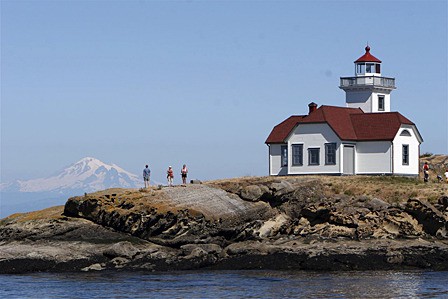Denise Wilk’s affinity for lighthouses is in her blood.
It all began with her grandfather, who emigrated from Denmark to Port Townsend in 1915. After being stationed in Fort Worden, he and his new wife moved to Coupeville, where they lived beside the old, wood Red Bluff Lighthouse. Their daughter (Wilk’s mother) was born within view of the grand structure. Wilk grew up in a family that appreciated the splendor and history of American lighthouses.
“We’re losing history and we need to keep it alive,” she said. “They’ve been rundown and rotting away. They’ve started going on the auction block. Lighthouses need caretakers again.”
Wilk joined the effort to preserve the Patos Island Lighthouse three years ago. The endeavor was spearheaded by Lopezian Linda Hudson and Bureau of Land Management (BLM) field administrator Nick Teague.
Patos, located five miles northwest of Orcas, is the northernmost point of the San Juan Islands. It is owned by BLM, who has restored the 1893 lighthouse structure. In cooperation with Washington State Parks and the Keepers of the Patos Light (KOPL), the plan is to open the lighthouse to visitors when docents are on site. The 117-year-old lighthouse was improved in 1908 with a new fog signal and a 38-foot tower. The light was automated in 1974. Still in use today, it flashes a white light once every six seconds with a red panel on the dangerous shoal side of the point.
Last summer, KOPL received word that its grant application to the Lighthouse Education Environmental Program was approved. The $1800 grant will be used to fund outreach and displays.
Volunteers made great strides in the island’s progress this past summer. The docent camp was busy, with volunteers picking up garbage off the beach, cutting grass, and clearing trails. The Orcas Island Fire Department has also contributed hours to maintaining the area. Visitors toured the lighthouse, and bought Patos-themed items in the outreach center. Wilk, who is also an artist, created t-shirts, mugs, and linoleum stamps depicting the San Juans’ four lighthouses: Cattle Point, Lime Kiln, Turn Point, and Patos.
KOPL is working on a interpretive trail proposal, which would lead visitors to historic spots on the island. The trail’s route will be based on sites mentioned in the memoir “The Light on the Island” by Helene Glidden, whose father, Edward Durgan, was the island’s best-known lighthouse keeper. He moved to Patos in 1913 with his wife and 13 children. The book was the inspiration for the formation of Keepers of the Patos Light.
The memoir was out of print until recently. In commemoration of its 60th anniversary, the publisher is re-releasing it in 2011 with an additional chapter that was originally left out after being deemed too risque for the time. It will also feature more photos and notes from Glidden. KOPL is selling the book as a fundraiser.
The trail will also serve as an educational tool for raising awareness about Patos Island’s sensitive cultural sites, and First Nations middens that are scattered throughout the island. BLM is working with archaeologists and the tribes to designate “no-go” zones.
“It’s a responsibility we take seriously,” Wilk said. “We love history and we want to preserve it.”
Patos Island is only accessible by private boat or charter, but Wilk anticipates that this summer will be a hopping time for the island. Wilk, who owns Orcas Island Eclipse Charters with her husband, helps coordinate visitor volunteers to the lighthouse throughout the summer months. The island is also a popular spot for “volunteer vacations,” where tourists from across the country come to stay in the KOPL camp and lend their services to the preservation of the grounds.
“When I am out there, I feel like it’s an ancient place that is very nurturing and healing,” Wilk said. “It’s a wonderful gift to go there.”
For more information
Visit patoslightkeepers.org



